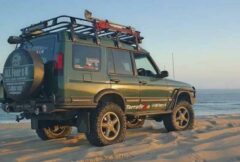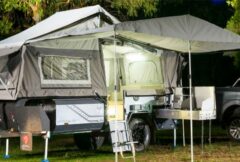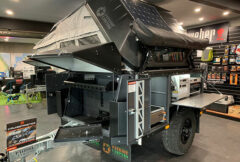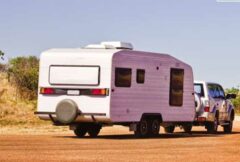Tents
Go on an adventure, get back to nature and enjoy the freedom.
Tent’s today makes getting back to nature a luxurious experience and there is a camping style for everyone from single person tents to tents large enough to fit the entire family.
A tent can be described as a collapsible shelter of fabric (as nylon or canvas) stretched and sustained by poles. Modern designs today offer a large range of styles, materials and accessories that will inevitably suit your requirements.
Camping is a relaxing and affordable way to enjoy a holiday, and your outdoor experience can involve hiking, kayaking, 4 wheel driving or an addition to your caravan site, a tent is a viable and affordable option.
Depending on tent size and the experience of the person or people involved, tents can usually be assembled (pitched) in between 3 seconds to 25 minutes; disassembly (striking) takes a similar length of time. Smaller tents may be free-standing or attached to the ground, large tents are usually anchored using guy ropes tied to tent pegs.
Considerations
Things to consider
- Flexible for camping
- Small and compact
- Easy to store
- Provides a more outdoor feel and experience
- No running costs
- Minor upkeep
- No facilities such as kitchen, bathroom/toilet
- Limited equipment and storage facilities
Space & Size
Consider how many people will sleep in it including storage of gear. A two person tent will fit two but with no gear. Also, consider the height and size of the campers, if one camper is broad or tall and may move around a lot in their sleep or you are confined to your tent due to the weather, a larger tent would be more appropriate.
The duration of the trip should also be considered as the longer the trip the more gear may need to be taken. Mattresses, backpacks etc will fill up the tent space very quickly.
Know your measurements of the tent you are needing.
Transport, Weight & Set up
Consider where you will be going and how you will get there. You may need to consider a smaller, lightweight tent if access to the campsite is other than driving such as hiking, kayaking etc. Keep in mind your capabilities – are you the only one in the family to unload the tent as some of the larger tents are extremely heavy to carry and require more than one person to set up.
Remember also – the bigger the tent, the bigger the campsite you will need. Some campsites are just not designed for big tents, and you will need to find a large, level spot, away from overhanging tree branches etc.
Modern tents are quite sophisticated and come in a wide variety of colours and sizes and can take 30 seconds to set up to a few hours so do some research before buying. In addition to visiting a supplier, visit Youtube as not only will it show you how to set it up, the reviewer is more likely to point out the pros and cons of that particular tent.
Weather Conditions
A tent should be compatible with the weather in which it will be used. Campers should usually assume that the weather they encounter will be more extreme than predicted and be prepared for any situation.
Styles & Categories
There are certain tent categories and styles to suit the various conditions and environment. In some cases, the style is defined by the tent’s purpose; in others it is defined by a tent’s shape or size.
Dome tents are quite common and are known for being fairly simple to set up and take down. They vary in sizes and are predominately used in campgrounds.
Summer tents are lightweight and heavily ventilated but not ideal for harsh conditions.
Three-season tents are suitable for every season except winter. These tents generally offer ventilation for warm weather and a rain fly used to protect sleepers during wet weather and can withstand heavier rains and winds. Varying in sizes, these are the more common form of tent purchased.
Four-Season/Winter tents are suitable for very cold conditions. The stronger, more durable materials used allow the warm air to remain inside and are more resistant to wind, as they have more anchoring points than three-season tents. The increased strength also makes it possible for the tents to withstand being covered with snow.
Family/Cabin tents are usually the largest tents available. They are typically large and square shaped, with a ceiling tall enough to allow many adults to stand fully upright while inside. In some cases, these tents have multiple rooms, allowing families to have some degree of privacy. Family tents are usually quite heavy and can be more difficult to set up than other tents. They are usually not used for hiking or activities that does not involve a vehicle for transport.
Ventilation & Water Resistance
Even if rain is not predicted during your trip, once again it is better to be prepared. Buyers should look not only at a waterproof roof but flooring as condensation can be an issue making the tent damp. An awning should also be considered as it provides addition shelter from both rain and sun.
Ventilation is important so look for well place condensation issues as many a camper has woken up to everything being damp. Clothing has touched the sides and your bedding is damp and condensation is all over the tent.
Preparing To Buy
Before you set off to buy your tent, take the time to ask yourself the following questions as the type of tent you choose will depend upon your needs and your budget.
- How much space do you need?
- How will you transport your tent?
- When will you use your tent?
- What type suits me?
- Do I need to worry if it rains?
Buying Tips
The following tips are applicable to any tent type:
- Tents are usually made of canvas, cotton or nylon. Check the quality of the tent you are considering buying by holding the fabric up to the light. Now look carefully at the weave. If the fabric is not even or closely knit, it is of poor quality.
- Also prior to purchase, check the quality of the tents stitching, especially near the corners which are the main stress points.
- After use, make sure your tent is dried thoroughly before it’s stored. If the tent is damp, mildew will form and quickly ruin the fabric. Avoid storing your tent on concrete, which will also encourage mildew.
Visit a NSW Caravan & Camping Show
Head to one of our amazing Caravan and Camping shows where you will see everything on display in one convenient place. Find the next show here
Talk to a CCIA Member
CCIA Members are specialists in Recreational Vehicles and can help to direct you to the right vehicle that suits your needs and budget.









